
I love the old South–lazy, muddy bayous, long days of afternoon heat studded with the calls of 1,000 different insects, the steamboats and Spanish moss. In keeping with a form of romantic imagery that is to my mind distinctly southern, is the consuming passion for fine horses and for racing them. Horse racing was what NASCAR is today. Every mother’s son wanted to have the fastest horse, and horse breeding for speed was a constant competition. It was not just a city thing, but a small town pastime as well, and for a time Brownwood had its own tracks and a bit of a grand reputation in the game itself.
One of the lost racetracks (I say lost because little is known about them now, even the locations were unknown for many years) was built in 1880 as part of the original fairgrounds in the town. “The first racetrack was a half a mile straight track this side of the bayou, near the old dam. This track was built in the seventies and many match races were run on it. The next track was a quarter mile straight track just across the slough where the ranchmen matched their cow ponies with sometimes $500 to $1,000 bets. This was in 1880,” reads an edition of The University of Texas Bulletin, published in 1918 that contains a description of the two tracks.
“In 1888, the first racing fair was held in Brownwood,” the Bulletin article goes on to describe. “The track and fairgrounds were on the little knoll where North Brownwood School is now and Mr. Tom Major’s home was used for an exhibit hall. The first harness race ever run in Brown County was run on this track. It was a match race between Mr. J. W. Champion’s horse Button, and Arkansas Traveler, from Waco, who was run by Tom Lawrence, a local druggist.”
“Button was a beautiful chestnut sorrel, a bald-faced horse that exhibited perfect form. He was very active and ran with quick, jerky steps. He was only five years old at the time of this race. Arkansas Traveler was quite a contrast to the spirited Button. He was a tired looking old roan colored horse with a drooping head, shaggy hoofs and floppy ears. ‘He had a sluggish expression,’ declared Mr. A.M. Davis, pioneer horse racer who witnessed the affair, ‘and looked as if he could hardly walk.’ Each horse won a heat, and then Arkansas Traveler came to life in the third heat. The rider reached down and woke up the Traveler at the get-away and the old horse opened up and left Button so far behind at the first quarter he pulled up and quit the race. Arkansas Traveler jogged around the course and won the race, and $10,000.”
The Brownwood track was known as the finest in the South, mainly because its surface was ideal for gaining the fastest times. The racetrack drew horses from all over the country, and the crowds were extraordinary, bringing in 15,000 spectators for one day during the 1903 fair. Several famous horses were developed at the Brownwood track, including a mare called Maude D who broke the world record at the time for the half mile.
It’s strange that nothing remains of such a once great enterprise. The Pecan Valley Genealogical Society endeavored to locate where the track and the old fairgrounds used to stand, and pinpointed an area behind what is now Commerce Square and Walmart. My husband and I drove out there to see if there was any visible trace of what could have been the old fairground track, but saw nothing likely.
The Brownwood racetracks, like most human endeavors, have disappeared into the vaults of time. It’s fun to remember though, to imagine the excited shouts from southern gentlemen decked out in their best suits while the dust was flying and glistening horses sprinted for the backstretch. Somewhere along the banks of the slow-moving Pecan Bayou, the whole pageant just slipped away, and is today nearly completely forgotten. The story of the rise and fall of the tracks has itself a sort of romantic, slow moving, distinctly southern feel to it, if you ask me.
***
Diane Adams is a local journalist whose columns appear Thursdays on BrownwoodNews.com
